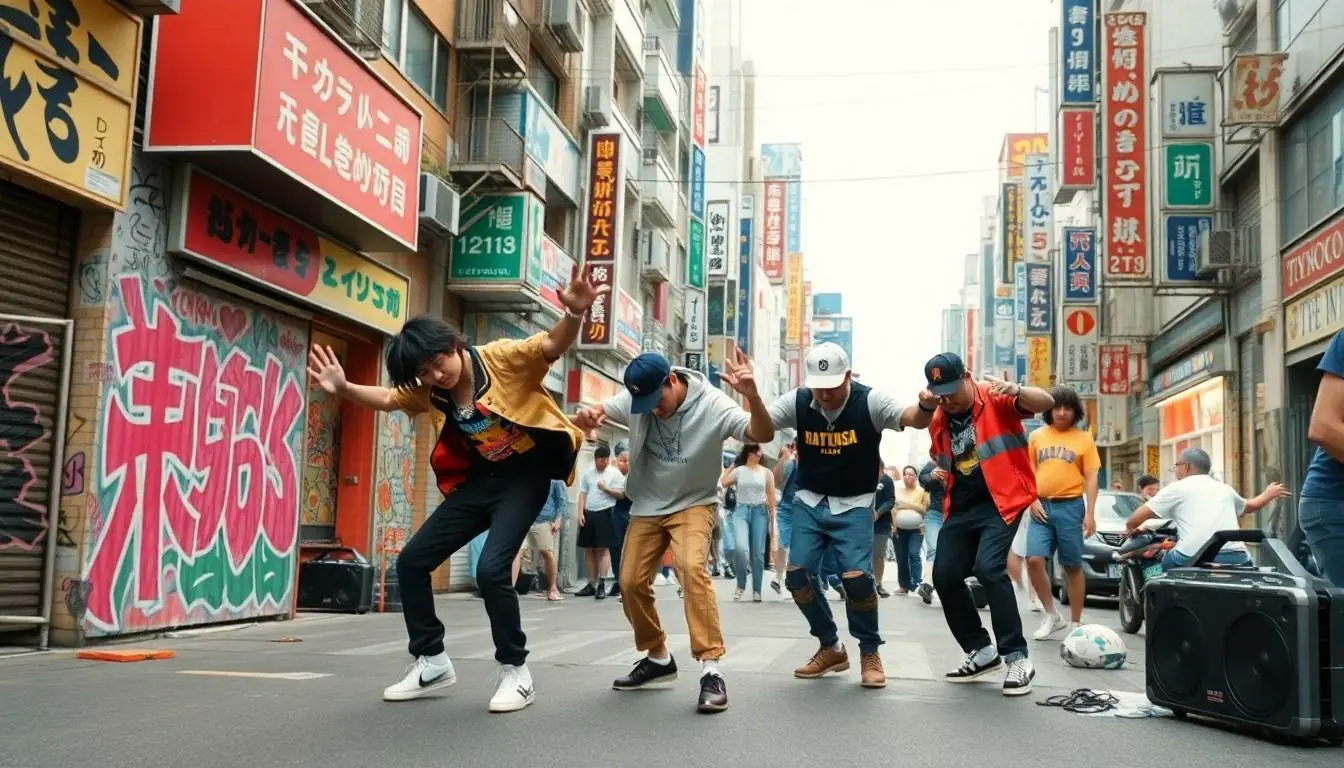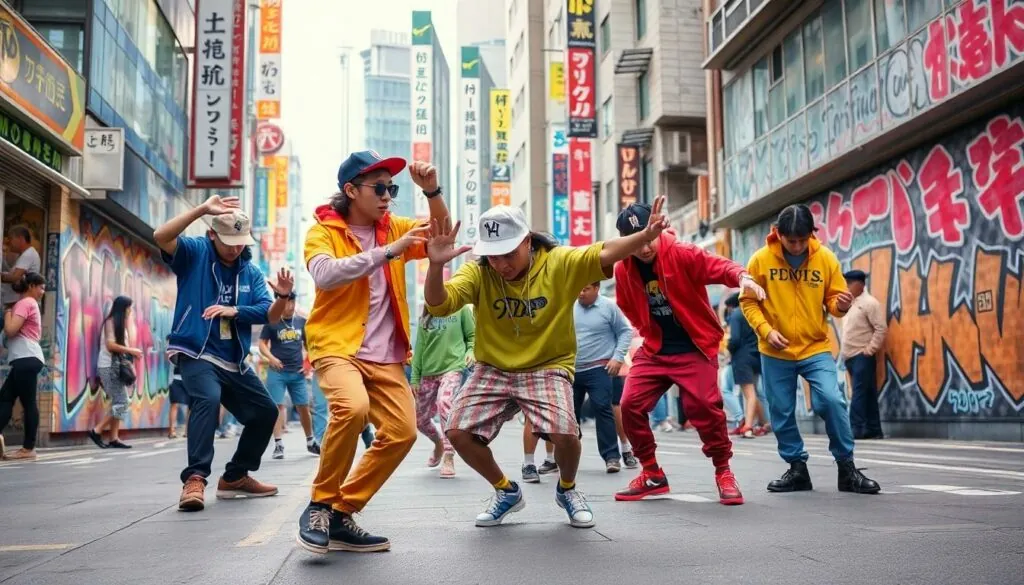Table of Contents
ToggleJapanese hip hop isn’t just a genre; it’s a vibrant cultural phenomenon that’s taken the world by storm. Imagine a fusion of traditional Japanese influences with the raw energy of street beats and lyrical prowess. It’s like sushi meets the cypher—unexpected yet deliciously captivating.
From the bustling streets of Tokyo to underground clubs, this genre showcases talented artists who effortlessly blend humor, storytelling, and social commentary. Whether it’s catchy hooks or clever wordplay, Japanese hip hop offers a fresh perspective that keeps listeners coming back for more. So, if you think hip hop is all about baggy pants and bling, think again. Dive into the colorful world of Japanese hip hop and discover why it’s a force to be reckoned with in the global music scene.
Overview of Japanese Hip Hop
Japanese hip hop emerged in the 1980s, influenced by American hip hop culture and integrated with local elements. It showcases a blend of traditional Japanese music styles and modern beats, creating a unique sound. Many artists draw inspiration from both their cultural heritage and the global hip hop scene.
Creative lyricism characterizes this genre, often combining elements of humor, storytelling, and social commentary. Artists like Nujabes and Ketsumeishi emphasize this narrative style while addressing social issues relevant to Japanese society. Tokyo serves as a central hub for this movement, with underground clubs and street performances spotlighting emerging talent.
Collaborations across genres have enriched Japanese hip hop, allowing for diverse musical expressions. Notable examples include partnerships between hip hop artists and J-Pop singers. Such collaborations expand the genre’s reach and appeal among broader audiences.
Festivals and competitions play a significant role in promoting this culture. Events like the B-Boy Japan Championships and the Yokohama International Jazz Festival highlight the dynamic nature of Japanese hip hop. These platforms provide artists opportunities to showcase their skills and connect with fans.
International recognition of Japanese hip hop is growing, with artists gaining attention in the global music landscape. This development illustrates the genre’s evolution and the impact of cultural exchange. Fans appreciate not just the music, but also the vibrant visuals and fashion that accompany performances.
Overall, Japanese hip hop presents a compelling fusion of influences that continues to captivate audiences both domestically and internationally. The creativity and innovation within this genre foster a thriving environment for artists and fans alike.
Historical Background

Japanese hip hop reflects a rich cultural tapestry that intertwines American influences and local traditions. The genre’s roots run deep, tracing back to the late 1980s when it first emerged in Japan.
Origins of Japanese Hip Hop
In the mid-1980s, exposure to American hip hop culture catalyzed the genre’s development. DJs and b-boys brought breakdancing and graffiti art into the Japanese urban landscape. Notably, the first hip hop tracks in Japan included elements of traditional music, creating a unique fusion. The street culture played a vital role, birthing underground scenes in urban centers such as Tokyo and Osaka. Artists began forming crews to showcase their talents, amplifying the genre’s visibility. By the early 1990s, Japanese hip hop steadily gained momentum, leading to the creation of distinct styles that resonated with local audiences.
Key Figures in the Early Scene
Prominent figures laid the groundwork for Japanese hip hop’s evolution. K Dubs, a pioneering rapper, significantly contributed to the scene’s early development. He released influential tracks that resonated with youth across Japan. Another key figure, DJ Krush, emerged as a notable producer, merging hip hop beats with atmospheric sounds. His work helped establish a unique sonic identity for Japanese hip hop. Additionally, the group Microphone Pager played a critical role in popularizing the genre, introducing innovative lyricism and performance styles. Their efforts showcased hip hop’s potential as a powerful voice for social commentary and personal expression.
Evolution of Japanese Hip Hop
Japanese hip hop’s evolution showcases a dynamic blend of cultural exchanges and musical innovation. The genre’s growth reflects various influences that shaped its distinctive sound.
Influences from Western Music
American hip hop culture significantly impacted Japanese hip hop since the mid-1980s. DJs began incorporating Western beats, styles, and techniques into their performances. Breakdancing and graffiti art also emerged as popular forms of expression, inspiring local artists. Early pioneers drew inspiration from artists such as Run-D.M.C. and Beastie Boys. Their work laid the foundation for many Japanese artists. By the early 1990s, collaborations with American artists began, further bridging cultural gaps. Increased access to hip hop media allowed for a greater understanding of the genre’s nuances in Japan.
Integration of Traditional Japanese Elements
Traditional Japanese music greatly enriches the sound of Japanese hip hop. Incorporating instruments like the shamisen and taiko drums adds a unique flavor to the genre. Lyricism often features themes from Japanese history, folklore, and social issues. Artists like Nujabes skillfully blend these elements with modern production techniques. This fusion creates a captivating contrast that resonates with diverse audiences. Festivals play a vital role in showcasing these innovative sounds, connecting hip hop with cultural heritage. Both contemporary and traditional influences demonstrate the genre’s versatility and depth.
Popular Subgenres
Japanese hip hop features several distinct subgenres that reflect its cultural diversity and artistic innovation. Two of the most notable subgenres are underground and mainstream hip hop, each with its unique characteristics.
Underground Hip Hop
Underground hip hop thrives in Japan, showcasing raw talent and experimental styles. Artists prioritize self-expression without commercial pressures, often tackling social issues through their lyrics. This subgenre fosters a tight-knit community, with live performances in small venues and frequent collaboration among local talent. Noteworthy figures include Komachi and MPC, who push artistic boundaries and explore the fusion of various musical influences. The underground scene significantly impacts the overall hip hop landscape, attracting dedicated fans who appreciate authentic artistry.
Mainstream Hip Hop
Mainstream hip hop in Japan has gained popularity, blending various musical styles to appeal to wider audiences. Major artists often achieve commercial success, drawing influence from global hip hop trends while incorporating local elements. Collaborations with mainstream J-Pop stars have become common, broadening the genre’s reach. Notable examples include artists like AKLO and Kyaria Pamyu Pamyu, who infuse pop melodies with hip hop beats. This subgenre contributes to the ongoing evolution of Japanese hip hop, offering catchy songs and increased visibility for emerging talents.
Impact on Culture and Society
Japanese hip hop significantly influences culture and society, reflecting the voices of its youth and fostering rich collaboration across genres.
Representation of Youth Voices
Youth voices resonate strongly within Japanese hip hop. Artists often address contemporary social issues such as identity, inequality, and mental health. Lyrics articulate the struggles and aspirations of young people navigating urban life. This focus on relatable themes encourages listeners to engage with the music on a personal level, fostering community and dialogue. The genre empowers youth, allowing them to express their experiences and connect with others. As listeners relate to these narratives, Japanese hip hop cultivates a sense of belonging and understanding.
Cross-Genre Collaborations
Collaborations across genres showcase the versatility of Japanese hip hop. Artists frequently team up with J-Pop singers, enriching their sound and expanding their audience. These connections create a fusion of musical styles, blending hip hop with pop, rock, and electronic music. Collaborations elevate the visibility of Japanese hip hop, drawing attention from both domestic and international listeners. Notable partnerships amplify artistic expression and introduce innovative sounds that resonate with diverse fan bases. By merging distinct genres, artists redefine traditional boundaries, illustrating the collaborative spirit ingrained in the music scene.
Japanese hip hop stands as a testament to cultural fusion and artistic innovation. Its roots in American hip hop have blossomed into a unique genre that reflects Japan’s rich cultural landscape. Through storytelling and social commentary, artists tackle pressing issues while connecting with youth and fostering community.
The genre’s ability to evolve and incorporate various influences ensures its relevance in today’s music scene. As it continues to gain international recognition, Japanese hip hop invites listeners to appreciate its distinctive sound and the vibrant culture it represents. With each beat and lyric, it captures the essence of a society in constant transformation, making it a compelling force in global music.





